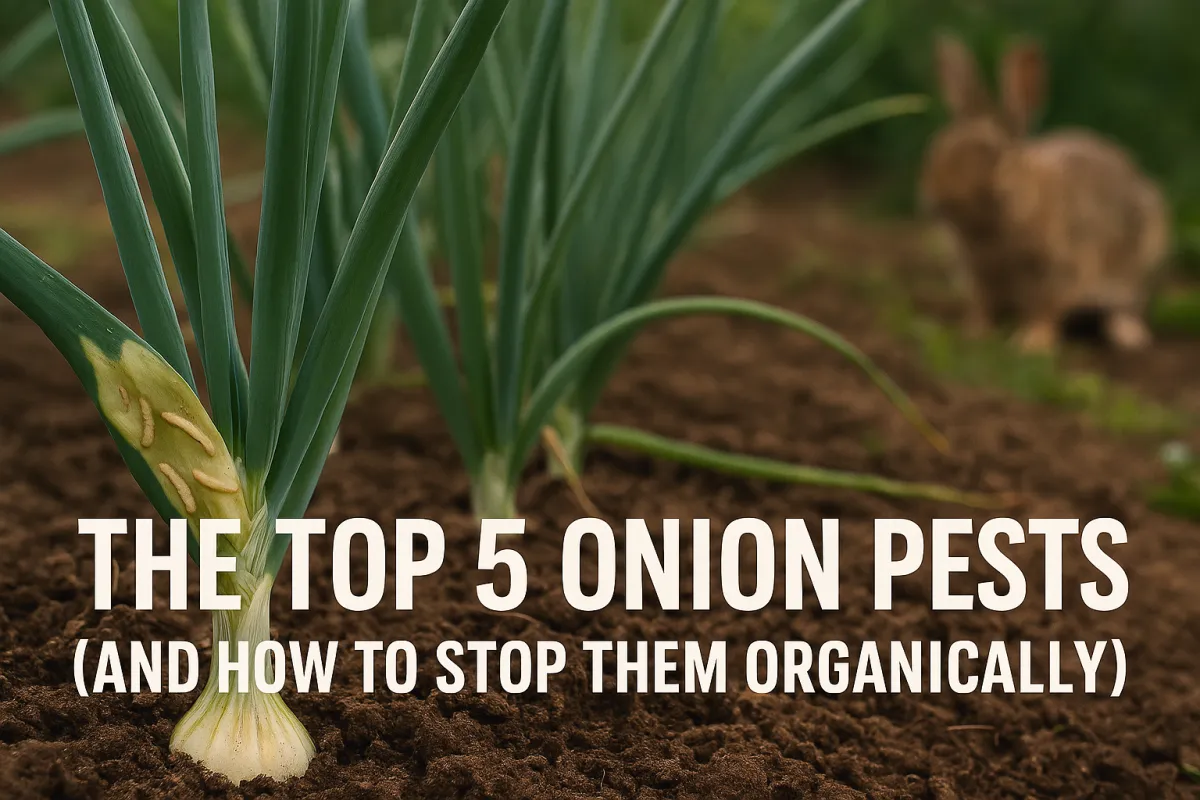
The Top 5 Onion Pests (and How to Stop Them Organically)
The Top 5 Onion Pests (and How to Stop Them Organically)
Intro: Lessons Learned from Losing Onions
I’ll never forget the year I lost nearly an entire onion patch. I thought onions were tough enough to fend for themselves, but pests had other plans. One week the seedlings were standing tall, the next they were flat, tunneled through, or chewed to the ground. That season taught me a hard truth: onions may be hardy, but they’ve got a handful of enemies that show up year after year.
The good news? Once you know what to look for — and how to fight back organically — you can keep your onions standing strong all season long. Here are the five worst offenders I’ve seen and the steps you can take to stop them.
Onion Maggots
How to Identify
Seedlings wilt for no reason, roots disappear, and if you pull one up you’ll see tunneling damage with tiny white larvae still at work.
Step-by-Step Organic Control
Cover your rows early. Floating row covers keep flies from laying eggs.
Rotate crops. Don’t plant onions where you’ve grown onions, garlic, or leeks in the last 2–3 years.
Prep your soil wisely. Avoid leaving half-rotted onion debris or excess organic matter that draws flies in.
Pro Tip: Never leave old onion bulbs or skins in the soil — they’re like a magnet for maggots.
Thrips
How to Identify
If your onion leaves look dusty or streaked with silver, take a closer look. Tiny thrips feed by scraping the leaves, leaving them weak and dry.
Step-by-Step Organic Control
Blast with water. A strong hose spray knocks them back before numbers climb.
Spray naturally. Neem oil or insecticidal soap works if you catch them early.
Recruit allies. Lacewings and ladybugs are natural thrip hunters.
Grandma’s Tip: “If your onions look dusty when the soil ain’t — look closer. Tiny thieves are at work.”
Cutworms
How to Identify
You walk out in the morning and a healthy onion seedling is lying flat, cut clean off at the soil line. That’s a cutworm at work.
Step-by-Step Organic Control
Collar your seedlings. A simple paper or cardboard collar blocks cutworms from wrapping around the stem.
Check the soil. Turn it before planting — tilling or hand-checking exposes and removes larvae.
Night patrol. If pressure is bad, grab a flashlight and catch them feeding.
Avoid This Mistake: Laying down mulch too thick and too early gives cutworms the perfect hiding spot.
Leafminers
How to Identify
Those winding, squiggly white trails in your onion leaves are the calling card of leafminers tunneling inside.
Step-by-Step Organic Control
Remove damaged leaves. Get rid of them fast before larvae mature.
Cover crops. Row covers keep adult flies from landing.
Rotate beds. Break their life cycle by not planting onions or related crops in the same soil back-to-back.
Pro Tip: Mix in carrots or lettuce nearby. The variety helps confuse pests and slow infestations.
Rabbits and Deer
How to Identify
Rabbits make clean cuts across leaves like they used scissors. Deer tear and pull, leaving ragged ends behind.
Step-by-Step Organic Control
Fence smart. Two-foot fencing stops rabbits; deer need eight feet or more.
Use deterrents. Garlic spray, predator scent, or motion sprinklers keep them guessing.
Plant a buffer. Herbs like rosemary, sage, and lavender act as borders animals don’t like to cross.
Faith Touch: Protecting the harvest is part of stewardship. We guard what God provides — not just for ourselves, but for the families who sit at our tables.
Region-Specific Notes
USDA Zones 3–7: Onion maggots and thrips are most common in cool, damp springs.
USDA Zones 8–10: Leafminers and deer pressure increase as weather warms and stays mild.
Closing: Protect Your Patch, Protect Your Harvest
The year I lost my onion crop taught me a simple truth — prevention is easier than rescue. If you start with clean soil, rotate wisely, and use covers or fencing where needed, you’ll save yourself the heartbreak of watching onions disappear overnight.
This season, begin with the basics: row covers for maggots, a sharp eye for thrips, and a bit of fencing if rabbits or deer call your place home. The more you guard early, the less you fight later.
👉 Next step: Grab the Onion Pest ID & Prevention Checklist — a printable you can keep in your shed so you never second-guess what’s chewing on your crop.


Facebook
Instagram
X
Youtube